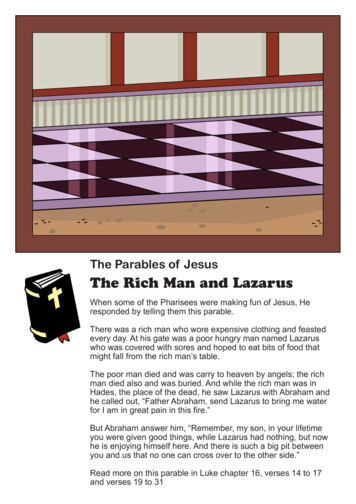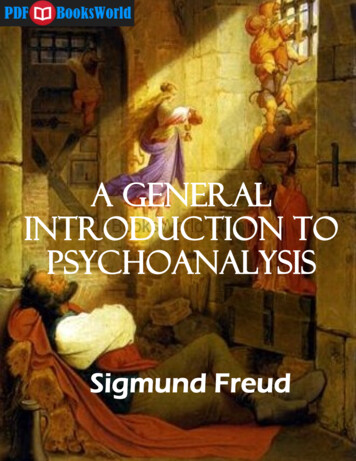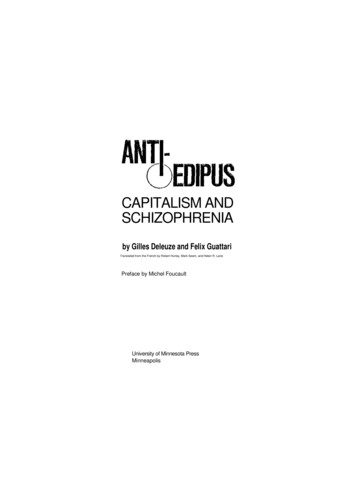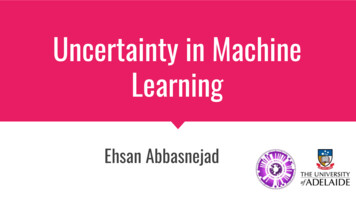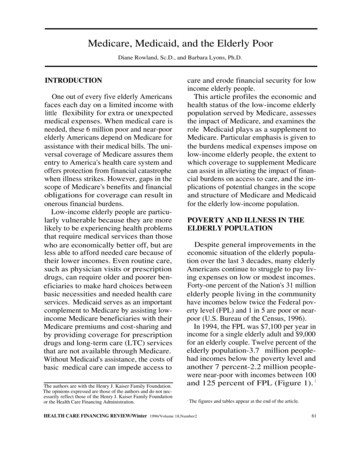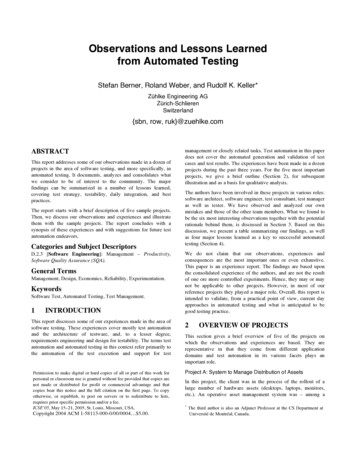
Transcription
"Poor Man's Psychoanalysis?"Observations on DianeticsRoy WallisThe sociology of marginal medicine is a neglected field of endeavor. Thereexist only a mere handful of brief accounts of unorthodox therapeuticpractices and their development in Western societies. I shall seek, therefore, to provide a contribution to this scant literature, in the belief thatsuch studies are not only of intrinsic interest but also provide insight into anumber of strains and tensions generated by advanced industrial societiesand into some of the less orthodox methods of coping with them. Thisessay offers an account of a marginal therapeutic system, Dianetics, whichbriefly emerged into prominence in the early 1950s.'Dianetics was the discovery of L. Ron Hubbard, an individual with acolorful past who began in 1948 and 1949 to formulate a theory of mentalfunctioning and a therapeutic practice, with which he experimented on asmall group of followers in New Jersey. Among these followers was a bookpublisher and the editor of Astounding Science Fiction magazine, John W.Campbell. Campbell, a. man of considerable influence on the magazine'ssubstantial readership, had a persistent sinusitis condition that was alleviated by Dianetics. He thereafter actively promoted the theory in hismagazine (Campbell 1949, p. 80).1. This article is based on extensive research into Dianetics and Scientologyundertaken by the author. This research involved interviews with members andformer members, the use of questionnaires, and the examination of a wide range ofdocumentary sources. The study was funded in part by a generous grant from theSocial Science Research Council. The research is reported in full in my book(Wallis, 1976a). This article draws heavily on Part II of this book and is an abbreviated and modified version of a longer paper (Wallis, 1976b). I am grateful to Dr.Bryan Wilson. Fellow of All Souls College, for advice and encouragement throughout, and to Professor John Lee. Scarborough College, University of Toronto, for hiscomments on an earlier version.
10THE ZETETICCampbell's excitement with this new discovery was readily conveyedto his readers, and inquiries began to flow into the magazine's editorialoffices asking for treatment by, or information on, the practice. In April1950 Hubbard and his associates established the Hubbard Dianetic Research Foundation. In the following weeks a lengthy article by Hubbardappeared in Astounding (Hubbard 1950); and, shortly after, he publisheda book describing the theory and practice. The trickle of inquiries turnedinto a deluge, and his book Dianetics: The Modern Science of MentalHealth (Hubbard 1968; original ed. 1950) rapidly became a best-seller.The theory of DianeticsHubbard construed the mind as possessing two parts. The first part, theanalytical mind, was a thoroughly rational unit that operated withcomputerlike efficiency and had capacities considerably greater thanthose exhibited by most human beings. The second part, the reactivemind, was thoroughly irrational and interfered with the analytical mind,thereby preventing it from achieving its full potential. The reactive mindhad evolved, Hubbard believed, as a means of protecting the delicatemachinery of the analytical mind. In the face of pain, emotional trauma,or other threat to the individual's survival, the analytical mind would"shut off," and the reactive mind—a more robust mechanism—wouldcome into operation. The reactive mind was a perfect recording device. Itstored all perceptual details of the entire period when the analytical mindwas not operating and directed the organism in ways which had, accordingto information stored in its "memory bank," previously led to the organism's survival. Hence, even during periods of what were normally construed as unconsciousness, the reactive mind would be recording. Knownas engrams, these recordings contained all the sensory (or what Hubbardreferred to as "perceptic") details of periods of pain, unconsciousness,emotional loss, or trauma, and all the associated affect.If, in the formation of the engram, words were spoken, these wordsmight have a later effect similar to that of a posthypnotic suggestion. If thewords were subsequently repeated, the engram would be "keyed-in," orpartially restimulated, and could subsequently lead the individual tobehave in "aberrated" ways, suffer physical or mental illness, or otherwiseimpair his capabilities.One of Hubbard's more radical "discoveries" was that the most important engrams, in terms of their effects on later behavior and perform-
11ance, were formed during intrauterine life. He gives examples of this inDianetics: The Modern Science of Mental Health, most of which involveviolence of some kind, either directed at the fetus in the form of an unsuccessful abortion attempt or between the parents of the fetus. One casewhich he reports involved 81 abortion attempts, which even Hubbardadmits was "an incredible number" (Hubbard 1968, p. 314).An example of such an engramic situation is described as follows:"Fight between mother and father shortly after conception. Father strikesmother in stomach. She screams (first percepts [sic] are pain, pressure,sound of blow and scream) and he says, 'God damn you, I hate you! Youare no good. I'm going to kill you!' Mother says, 'Please don't hit meagain. Please don't. I'm hurt. I'm hurt. I'm frantic with pain!' Father says'Lie there and rot, damn you! Goodbye!' " (Hubbard 1968, p. 262).Hubbard observes that such an engram can produce disease ("androt") or lead the "aberree" (i.e., the individual with the engram—in thiscase, the fetus in later life) to feel other people are no good ("You are nogood") and to feel hostility toward them ("I hate you").The purpose of Dianetic therapy (known as auditing or processing)was to locate and gain access to engrams and to "erase" them from thereactive mind, thus eradicating their effects in the form of psychosomaticillness, emotional tension, or lowered capability, by permitting the analytical mind to operate unimpeded.Exhausting the reactive mind of engrams would, hence, have anumber of highly desirable consequences. The individual would become"self-determined," rather than having his actions determined by hisengrams. The analytical mind, being a perfect computer, would alwayssupply the correct answer from information fed into it when relieved of theengrams which led to error. The individual's IQ would rise dramatically.He would be free of all psychological or psychosomatic illness, his resistance to physical illness would be vastly improved, and he would be ableto cure himself of other illnesses or injuries much more rapidly. He would,in short, be a "clear." In order to achieve this state, however, it was necessary to locate and release the earliest, or "basic-basic," engram, which hadusually occurred shortly after conception.TherapyTherapy proceeded in the following manner: The pre-clear (or patient) layon a bed or couch in a quiet room, while the auditor (or therapist) sat be-
12THE ZETET1Cside him. "The auditor tells him to look at the ceiling. The auditor says:'When I count from one to seven your eyes will close.' The auditor countsfrom one to seven and keeps counting quietly and pleasantly until thepatient closes his eyes. A tremble of the lashes will be noticed in optimumreverie" (Hubbard 1968, p. 159).Hubbard insisted that the process of inducing "Dianetic reverie" wasquite different from hypnosis. To ensure against hypnotic suggestion,however, a "canceller" was installed. That is, the pre-clear was told: "Inthe future, when I utter the word Cancelled, everything which I have saidto you while you are in a therapy session will be cancelled and will have noforce with you. Any suggestion I have made to you will be without forcewhen I say the word cancelled. Do you understand?' " (Hubbard 1968,p. 200).The pre-clear was assured he would be aware of everything that happened. When the pre-clear had entered the state of reverie, the auditorwould, after various preliminaries, direct the pre-clear to return to "basicbasic." Generally, however, the basic-basic engram was not located sosimply, and other, "later-life" engramic material would be brought up.This material had to be "reduced," that is, the pre-clear was asked toreturn to the beginning of the incident and to recount all the perceptualdetail involved in it. He would be directed to recount the incident over andover again, until all the emotion involved in it was discharged.The pre-clear would then be directed to another, it was hoped, earlier,incident, and the process would be repeated. Ideally, "basic-basic" wouldbe located and erased and the pre-clear then progressively cleared of allsubsequent engrams. Often, however, this would not occur, and it wouldtherefore be necessary to end the session at some convenient point. Thatpoint was usually after the "reduction" of an engram, that is, when all theaffect associated with a particular incident was discharged. A Dianeticssession usually lasted for around two hours, but it might continue formuch longer if the pre-clear was "stuck in an incident," that is, in anengram.At the end of the session the pre-clear would be told to "come up topresent time." The auditor might then question him as to the time,location, and so forth to ensure that he was "in present time." He wouldthen say "Cancelled" and end the session. "(Work continues until theauditor has worked the patient enough for the period). Come to presenttime. Are you in present time? (Yes) (Use canceller word.) When I countfrom five to one and snap my fingers you will feel alert. Five, four, three,two, one. (Snap)" (Hubbard 1968, p. 202).
13Oianetics as a cure for illnessHubbard viewed Dianetic therapy as a uniquely efficacious means of resolving psychosomatic illnesses (which he believed to include at least 70percent of all known illnesses). "Arthritis, dermatitis, allergies, asthma,some coronary difficulties, eye trouble, bursitis, ulcers, sinusitis, etc. forma very small section of the psychosomatic catalogue. Bizarre aches andpains in various portions of the body are generally psychosomatic. Migraine headaches are psychosomatic, and with the others, are uniformlycured by dianetic therapy. (And the word cured is used in its fullestsense)" (Hubbard 1968, p. 92).Even the common cold was psychosomatic, and those cleared byDianetics, it was said, did not suffer from colds (Hubbard 1968, p. 92).Further, "a number of germ diseases are predisposed and perpetuated byengrams. Tuberculosis is one " (Hubbard 1968, p. 92). So, there are fewills to which mind or flesh are heir that could not be helped by Dianetics.While Hubbard claimed only to be concerned with producing atheory of the mind and of illness formation on a functional basis and saidthat structural explanations for the phenomena generated by his practice,or for its success, would follow, he occasionally suggested structural hypotheses to guide future researchers: "Arthritis of the knee, for instance,is the accumulation of all knee injures in the past. The body confuses timeand environment with the time and environment where the knee was injured and so keeps the pain there. The fluids of the body avoid the painarea. Hence a deposit which is called arthritis" (Hubbard 1952, p. 32).Such matters, however, were of less concern to Hubbard than wasproducing a theory and method which worked.Dianetics was initially presented as a practice which anyone of normal intelligence could successfully undertake. A thorough knowledge ofthe book Dianetics: The Modern Science of Mental Health was thought tobe all that was necessary, and hence interested persons could "co-audit"each other on the basis of their knowledge of this work (Hubbard 1968,p. xxii). Professional courses were soon established, however, and thoseinterested were encouraged to undertake four weeks of training at a fee of500 dollars to secure certification as a Hubbard Dianetic Auditor.Membership and motivationWhile Hubbard's book drew many followers briefly to Dianetics, mostabandoned it as rapidly as they had taken it up. A core of followers re-
14THE ZETETICmained, however, and concerning these there is available a certain amountof demographic and motivational data.2 The most heavily representedage group in Dianetics was that from 27 to 40 years of age, with theaverage age estimated to be about 38 years. The sex distribution showed aclear male overrepresentation, and the occupations of followers displayeda marked clustering in white-collar occupational categories. Manual workers were not typical, and indeed the occupational data show a markedtendency for members to have had professional, semiprofessional, or othernonroutine white-collar occupations. As one would therefore expect, theeducational level of Dianeticists was higher than that of the general population. Most had completed secondary education, and a large proportionhad attended a college or university. Further, available data show that Dianeticists were predominantly consumers of science-fiction literature; theywere largely Protestants or agnostics; and many had already acquaintedthemselves with at least one quasi-philosophical-psychological system,such as Count Alfred Korzybski's General Semantics. They tended also,almost without exception, to be white.The divergence from the general pattern of followers of othermarginal therapeutic movements in Western societies, in which femalesare typically overrepresented, can be accounted for by the broader scope ofDianetics. Although heavily promoted as a therapeutic system, it did notrestrict its domain to the area of physical healing. Rather, its therapeuticcapacity was seen as particularly relevant to psychosomatic illness andpsychological improvement. Thus much of its appeal was as a lay psychotherapy and self-improvement system rather than merely as a means ofcuring chronic physical illness. Motivations for taking up Dianetics can beseen as falling into three analytically distinct categories.1. The problem solver. Most individuals recruited to Dianetics werepreoccupied with a concern for self-improvement, based upon an acuteawareness of their failure to attain the standards of achievement in someareas of life that were approved and reinforced in the society around them.Their concern might be for improvement of a physical, psychological, orsocial kind. The search for therapeutic efficacy was a prominent source ofmotivation for many of those who were attracted to Dianetics. Dianeticists sought relief for themselves or other members of their families from2. The demographic data derives primarily from a survey conducted by a Dianetic newsletter and reported in The Dianews 1, 23 (15 June 1952). The motivational data derive from my own documentary analysis, interviews, and questionnaires.
15conditions as diverse as cancer, schizophrenia, and agoraphobia.A large number of Dianeticists, although it is impossible to say whatproportion of the total, had a strong sense of capacities latent within themwhich could be brought to the surface if only a method could be found. AnEnglish respondent, for example, indicated that he had hoped Dianeticswould prove the solution to his "sense of frustration at not being able tofully use talents I possess." Others admitted to having a deep sense of inferiority or insecurity, which they hoped Dianetics would enable them toovercome.2. The truth seeker. Many individuals were attracted to Dianeticswhen they came upon it at some point during a lifelong search for meaningand truth. During the course of this search they had often examined theliterature of popular philosophy and psychology, of religion, metaphysics,and occultism. Science fiction, with its panoramic vision of man, time, andthe cosmos, also provided many with insight into the meaning of life andhuman behavior. Dianetics, with its assertive claims to infallibility, offeredto answer many of the questions which puzzled such individuals and offered a practical and easily operationalized technique to put into effect thetruths which it had uncovered. Others came into the orbit of Dianeticsbecause a member of an amateur psychology or philosophy discussiongroup with which they were associated drew their attention to it.3. The career oriented. A small proportion of individuals were attracted to Dianetics as the source of an alternative career as a professionalDianeticist, or by the possiblity that Dianetics was a revolutionary newtherapeutic tool which would greatly improve their current practice astherapists, orthodox or unorthodox.Societal reactionWhile the response of the book-buying public rapidly placed Hubbard'sbook on the best-seller list, it was not everywhere received with enthusiasm. Reviews by psychologists and psychiatrists were almost uniformlyunfavorable. Objections were raised to its monocausal determinism andgrandiose promises and to its claims to scientific exactitude and an extensive experimental background; and fears were voiced that the severely illmight fatally waste time in Dianetic therapy before seeing a doctor.3 Moresympathetic reviewers suggested that Dianetics was harmless enough and3. Among the hostile reviewers were Rollo May (1950) and Martin Gumpert(1950).
16THE ZETETICmight possibly even be of help to socially isolated individuals.4 The benefits of the pre-clear's having a sympathetic listener while he ventilated hisproblems was recognized by some reviewers, who nevertheless remainedconcerned about the effects this might have in untrained hands in cases ofsevere mental disorder (Anonymous 1951a, p. 2). Although some of thesereviews may have attracted people to Dianetics, it was the view of informedDianeticists that the reviews in the larger-circulation periodicals andnewspapers were generally so unfavorable that they led many to fall away.Apart from numerous marginal, limited, and quasi-medical converts,Dianetics was received coldly by the medical, psychiatric, and psychological professions. Dr. Gregory Zilboorg publicly attacked Dianetics before aforum at the New York Academy of Medicine (Anonymous 1951b, p. 6),and a resolution of the American Psychological Association calling onpsychologists not to employ Dianetic techniques in their therapy waswidely reported (Anonymous 1950a, p. 2). Dr. Joseph Winter, medicaldirector of the first Foundation, attempted to interest his professional colleagues in Dianetics, but with little success. And Dr. Morris Fishbein, aspokesman for the American Medical Association, castigated Dianetics asyet another "mind-healing cult" (Anonymous 1950b).Some in the medical profession clearly held the view that there was aneed for more-active steps to be taken to deal with what was seen by somedoctors as a form of quackery. In January 1951 it was reported in a Bulletin of the Dianetic Foundation that the New Jersey Board of MedicalExaminers had initiated an injunction, which was later vacated, againstthe Foundation, for conducting a school of medicine without a license. Itwas almost certainly as a result of the publicity given to this action thatcreditors of the Foundation began to demand settlement, which led to reorganization and centralization of the Foundation in Wichita, Kansas.The decline of DianeticsThe major external source of the decline of Dianetics was the fall-off innumbers of new recruits, which led in turn to a financial crisis. The centralorganization of Dianetics was poorly administered. Hubbard was lecturingin various parts of the country and commuting between Los Angeles andNew York during late 1950 and early 1951, and giving little direction to4. More sympathetic was the review by Willard Beecher and Calder Willingham(1951).
17either of these Foundations in their day-to-day administration. Heprogressively alienated other board members by his practice of initiatingdevelopments without consulting them and by what some of them viewedas his increasingly evident authoritarianism.Large numbers of staff were recruited in the early months withoutadequate supervision. Foundation income was expended on the assumption that the Dianetics boom would long continue. However, by the beginning of 1951 applications for training and therapy began to drop off andincome fell correspondingly. In part, as I have argued, the decline in numbers of new recruits to Foundation services was precipitated by attacks onDianetics in the press by doctors and psychiatrists and by scathing reviewsof Hubbard's book.Recruitment may also, to some extent, have been affected by adversepublicity resulting from a divorce action in which Hubbard was involved.In particular, however, the decline in numbers was due to the failure ofDianetics to live up to its promise in the eyes of its early public. The stateof "clear" that would, it had been promised, emerge after only 20 hours ofauditing had not made its appearance, and many individuals who hadbeen working at the technique found their "cases" had improved little ornot at all and gave up.Yet another reason for attrition was the presentation of Dianetics as apsychotherapy. Whatever their feelings about the state of "clear," manypeople had gone into Dianetics to solve relatively specific problems ofillness or psychological handicap. Whether through spontaneous remission, the hope given them by Dianetics, the attention they received as preclears, or the therapeutic validity of the practice, a number had felt improved. Having secured what they had wanted from Dianetics, some discontinued their involvement.The Foundation moved toward a financial crisis. Hubbard's codirectors began to resign and the creditors to .press for payment. Don Purcell, a Wichita businessman and ardent Dianeticist, offered; to assist theFoundation in getting out of its difficulties. The corporation was centralized and its assets moved to Wichita, Kansas, in April and May 1951,where Purcell made funds and a building available. Purcell became president of the Foundation and Hubbard its vice-president and chairman ofthe board of directors. The other branches were closed down and thenumber of staff drastically reduced. The New Jersey creditors, however,pressed for settlement of the original Foundation's debts, and a courtdecision declared the Kansas operation liable as its legal successor. A
18THE ZETETICreceiver was appointed. A compromise settlement of the claims was negotiated, but new claims were filed by other creditors.Hubbard broke with his colleagues at this point (they then declaredthe Foundation bankrupt) and moved to Phoenix, Arizona, where he publicized new developments in his theory and practice, which he called Scientology. Scientology, far from being a lay psychotherapy, developed progressively into a highly professionalized religious philosophy and wasshortly incorporated as a church.Self-improvement and healing cultsDianetics has a place in a continuing tradition of self-improvement movements in the recent history of the United States. Enormously acceleratedsocial mobility and a prevalent ideology of individual achievement led to aconcern for infallible techniques that would ensure success for themobility-oriented. The late nineteenth and early twentieth centuries sawthe appearance of various movements and organizations offering access toadvanced, occult, metaphysical, or otherwise esoteric knowledge, andsome which, more cynically, merely offered certification that access tosuch knowledge or training had been obtained. The "diploma mill"became an established, if derogated, institution. Movements such as NewThought suggested that prosperity and success were available to everyone.The use of a few simple techniques would enable anyone to overcome thelimitations which he believed held him back (Griswold 1934).Dianetics also found a place in the continuing tradition of healingmovements in the United States. Indeed, the two traditions overlapped toa large degree—movements within this domain offering both healing andself-improvement and certifying "professional" competence in the practices purveyed (Steiner 1945). The development of science, particularlymedical science, during the nineteenth century led, John Lee has cogentlyargued, to increased expectations regarding physical health and comfort(Lee 1970, pp. 5-7). These expectations were in excess of what medicinecould actually achieve.The new healing movements such as Christian Science and NewThought offered a means of overcoming this gap between expectation andperformance in the realm of physical healing. Medicine became increasingly specialized and compartmentalized, and allopathic medicine directed attention to the disease rather than the individual, which led to adepersonalization of the practitioner/client relationship. The new healing
19movements, on the other hand, retained a personal orientation, a concernfor the "whole man." Hence, it has been argued that the role of the practitioner in such movements is closer to that of the psychotherapist than tothat of the medical practitioner.As, during the early twentieth century, medical practice became morecompetent to deal with physical illness, expectations of health and wellbeing became increasingly centered on the psychological domain and thedifficulties of interpersonal relations. Movements, like Christian Scienceand New Thought, that had claimed efficacy in handling physical illnesslost ground, while others arose offering psychological well-being, release ofmental and emotional tension, cures for psychosomatic and neuroticillness, techniques for releasing hidden inner abilities, and means of"making friends and influencing people." In such areas science has as yetmade little concrete progress, and the market remains open to culticgroups offering knowledge and techniques produced by more mystical,occult, or pseudoscientific means. Whatever the source of such knowledge,the prestige of science has become such as to require that almost every newmovement entering this field claim scientific legitimacy and authority, ifby no other means than that of incorporating the word science in its title. 5DiscussionDianetics struck a powerful resonance in the minds of many Americans inthe post-World War II period. It offered a rationale for failure in socialmobility and in social interaction. It provided an explanation for thisfailure in terms of traumatic incidents in which the individual had beenunwittingly involved and thereby relieved him of responsibility for hisfailure. All the past mistakes, failures, and sources of guilt could be wipedout. But most important of all, it offered one a means of eradicating thepersisting causes of failure, and thus of attaining the level of achievementto which he aspired. In a status-striving age it provided a means of improving the individual's chances of status mobility. The theory of Dianetics assured its adherent that his "true self," his conception of what hebelieved he was really capable of achieving, was indeed as he conceived it.It reaffirmed this idealization of self and promised a means of eliminatingthe barriers to its fulfillment, of eradicating the gap between his "true5. For example. Science of Mind, Science of Creative Intelligence, ChristianScience, Dianetics: The Modern Science of Mental Health.
20THE ZETETICself" and the identity that was typically confirmed in social interaction.Moreover, Dianetics provided a means for understanding not only oneselfbut also for understanding others, a way of categorizing and accountingfor their behavior and a guide to appropriate responses.Dianetics seems to have been seen as an acceptable and legitimatesolution to the problems with which recruits were faced, for two reasons:either they had tried alternative systems of belief and practice and foundthem unsuccessful; or they had rejected such alternative systems asinappropriate to their situation.Many of those whom I interviewed claimed an acquaintance with theliterature of psychology and expressed dissatisfaction with it. Psychology,as far as they could see, in the 1940s was split between behaviorism andpsychoanalysis. Behaviorist psychology seemed to them to have little or norelevance to man in general and no solution to their problems in particular. Psychoanalysis, while it addressed many of the problems which theyfaced and offered solutions, had two major drawbacks. First, analysisseemed an inordinately lengthy process, often lasting several years.Second, it was too expensive for most to consider it a practical proposition.Those who were suffering physical ills or disabilities had generallytried medical means of overcoming them but found little satisfaction frommedical professionals, few of whom recognized the essentially psychological or social basis of many of the complaints presented to them. Illequipped through lack of training to cope with the needs of such patients,they resorted to pharmacological or surgical treatments that, while successful in some cases, left others feeling the need for a treatment practicewhich took greater account of man as a whole. Other individuals, sufferingchronic illnesses for which medical treatment had proved unsuccessful orfrom illnesses for which effective therapeutic interventions had not yetbeen discovered, had exhausted all the resources that orthodox medicinecould offer. Individuals suffering both physical and mental problems hadgenerally sought solutions in a variety of other therapeutic practices beforethey came in contact with Dianetics.Bureaucratization and the scale of modern, urban society produce acontext in which many individuals experience a lack of control over theirdestiny and environment, a sense of being moved and constrained byforces beyond their control. Many of those adherents of Dianetics who didnot conceptualize their situation in medical or psychological terms experienced the world in which they lived as more or less unpredictable,chaotic, or meaningless. They sought some means of
Dianetics was the discovery of L. Ron Hubbard, an individual with a colorful past who began in 1948 and 1949 to formulate a theory of mental functioning and a therapeutic practice, with which he experimented on a small group of followers in New

